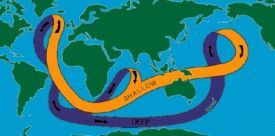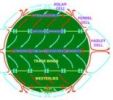We previously posted the prediction of the next solar maximum in this article. Now, another article from NASA on essentially the same topic offers a different twist; the notion of similarities between the terrestrial ocean “conveyor belt” and a conveyor belt phenomenon postulated to occur in the solar interior are considered in the article:
It’s official: Solar minimum has arrived. Sunspots have all but vanished. Solar flares are nonexistent. The sun is utterly quiet.
Like the quiet before a storm.
[more]
 In the article, they refer to the “ocean conveyor belt” which is an attribute of ocean circulation patterns. These patterns can alter the climate in certain areas . For example, the Gulf Stream portion of the “conveyor” keeps Northwestern Europe more temperate than normal for a high-latitude area. Likewise, Hawaii is cooler than many 20th latitude tropical areas due to the California Current, another segment of the “belt.” Left: Illustration of ocean circulation “conveyor belt” – NASA
In the article, they refer to the “ocean conveyor belt” which is an attribute of ocean circulation patterns. These patterns can alter the climate in certain areas . For example, the Gulf Stream portion of the “conveyor” keeps Northwestern Europe more temperate than normal for a high-latitude area. Likewise, Hawaii is cooler than many 20th latitude tropical areas due to the California Current, another segment of the “belt.” Left: Illustration of ocean circulation “conveyor belt” – NASA
The article describes the solar circulation pattern a bit more:
The sun’s conveyor belt is a current, not of water, but of electrically-conducting gas. It flows in a loop from the sun’s equator to the poles and back again. Just as the Great Ocean Conveyor Belt controls weather on Earth, this solar conveyor belt controls weather on the sun. Specifically, it controls the sunspot cycle.
[ . . . ]
The top of the conveyor belt skims the surface of the sun, sweeping up the magnetic fields of old, dead sunspots. The ‘corpses’ are dragged down at the poles to a depth of 200,000 km where the sun’s magnetic dynamo can amplify them. Once the corpses (magnetic knots) are reincarnated (amplified), they become buoyant and float back to the surface. Presto — new sunspots!
 I think the comparison between the solar circulation and Earth’s ocean circulation is interesting, but the circulation of solar plasma is probably more analogous to the triple-cell atmospheric circulation model here on Earth, where there is lateral motion due to the rotation of the planet and Coriolis forces. Since the sun is effectively gaseous (albeit dense), the same sorts of forces should be in effect.
I think the comparison between the solar circulation and Earth’s ocean circulation is interesting, but the circulation of solar plasma is probably more analogous to the triple-cell atmospheric circulation model here on Earth, where there is lateral motion due to the rotation of the planet and Coriolis forces. Since the sun is effectively gaseous (albeit dense), the same sorts of forces should be in effect.
Left: Triple circulation cell illustration – WikiPedia
Don’t forget that both conveyor belts on Earth are driven by the energy of the Sun. The added insight into the Sun’s most complex workings will continue to benefit mankind. As solar research continues and we learn even more about the Sun, it will better enable us to prepare for the terrestrial effects of solar activity, whether it be for colder or warmer.
